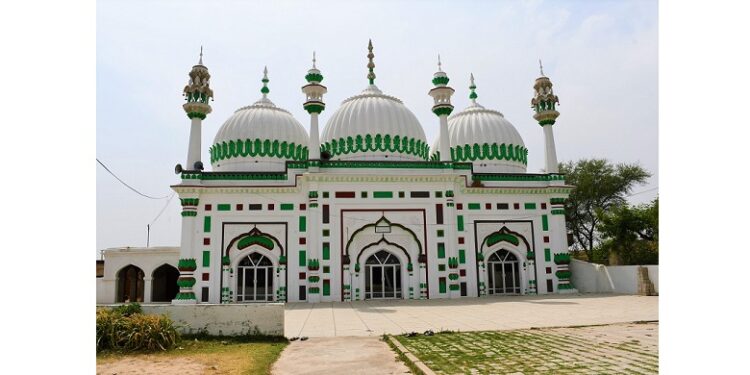
The land of Chakwal district is home to many shrines of female saints.
Zulfiqar Ali Kalhoro
I visited many shrines in different villages and towns during my research on female saints in Pothohar. During the research, I came across a few shrines of female Sufi saints who were known for their piety. Those mystic women in Pothohar continued their legacies after the death of their fathers. One such mystic woman was Mai Takhat Bi of Tharpal village in Chakwal district, who became the custodian (gaddi nashin) of the darbar of her father Syed Abbas Ali Shah Hamdani. Tharpal village is located about 14 km east of Chakwal on Choa Saidan Shah Road. Mai Takhat Bi was the daughter of Syed Abbas Ali Shah Hamdani, who was an eminent Chishti Sufi in the village. According to Muhammad Shafqaat Hyder, the Gaddi nashin of the shrine of Syed Abbas Ali Shah Hamdani, he was a disciple of Syed Ghulam Hyder Ali Shah, whose shrine is located at Jalalpur in Jhelum district. Syed Ghulam Hyder Shah (d. 1908) was a deputy (Khalifa) of Khawaja Shamsuddin Sialvi (1799-1883) who himself was a deputy of Khwaja Shah Suleiman Tanusvi alias Pir Pathan, a deputy of Khwaja Noor Muhammad Maharvi (d. 1793) whose shrine is located in Chishtian in Bahawalnagar district in Punjab Province.
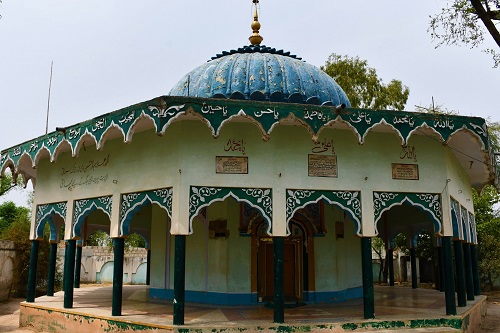
Syed Abbas Ali Shah was initiated into Chishti Nizami Silsila by Syed Ghulam Hyder Ali Shah. After receiving the robe of initiation (khirqa) he returned to his village where he established khanqah and began preaching Chishti Silsila in his area. Many people responded to his teachings and became his disciples. He held great influence and respect among locals. According to Abid Minhas Siddiqui (2019), the author of Tazkirah Auliya Chakwal Syed Abbas Ali Shah Hamdani son of Karam Shah Hamdani migrated from Danda Shah Bilawal in Talagang and settled in Tharpal village where he got married. He had one daughter whose name was Mai Takhat Bi. She was a pious lady who spent most of her time in prayers. After the death of her father in 1917, she became the gaddi nashin of darbar of her father.
In the Pothohar region in Punjab, it was seen that a few mystic women became the gaddi nashin after the death of their father and continued their missionary work. The most prominent was Syed Noor who became Gaddi nashin when his father Hafiz Hayat Bakhsh, an eminent Qadiri Naushahi saint of Kirpa village in Islamabad, died in 1881.
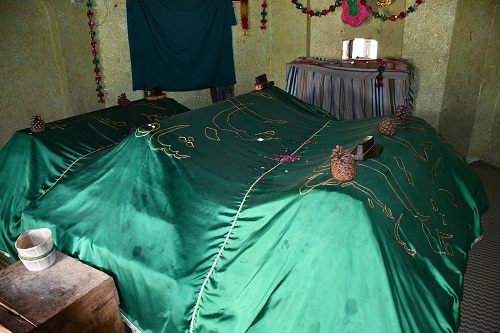
Like Syed Noor, the daughter of Hafiz Hayat Bakhsh Naushahi, Bhag Bhari, the daughter of Qazi Illahi Bakhsh Qureshi, also continued the missionary work of her father, and many people became her disciples. Qazi Illahi Bakhsh Qureshi was a deputy of Hafiz Hayat Bakhsh Qadiri Naushahi. On the instruction of his spiritual master, he preached in Bhagwal village in Chakwal. He died in 1896 and was buried in Bhagwal village. After his death, his daughter Bhag Bhari became the Gaddi nashin of darbar of her father and continued the legacy of her father in her village and other areas in Chakwal. Bhag Bhari died in 1922 and was succeeded by her sister Noor Bhari. She became the gaddi nashin of the shrine of Qazi Illahi Bakhsh Qureshi. Both Bhag Bhari and Noor Bhari are buried in the tomb of Qazi Illahi Bakhsh Qureshi in Bhagwal village. There are three graves in the tomb, having Qazi Illahi Bakhsh Qureshi in the centre. On the Western side of Qazi Illahi Bakhsh Qureshi’s grave is buried his daughter Noor Bhari while on the eastern side is his eldest daughter Bhag Bhari.
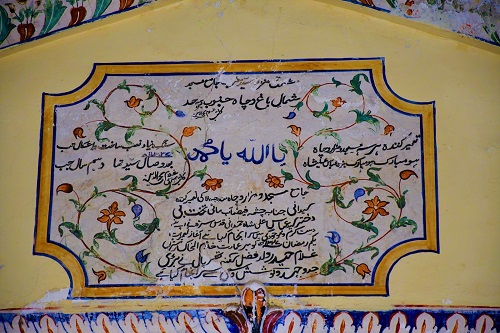
The land of Chakwal district is home to many shrines of female saints. These include the shrines of Bibi Lal near Takiya Shah Murad on the right bank of Bhanhao Nala, Khan Bibi at Chaukhandi Sharif, Burhan Bibi at Dulhah village, Bibi Syedi Sahiba at Dulmial, Hozan Bi at Chhonbi village, Doli Mai at Neela village, Alam Khatoon Bibi in Lawa, Mai Mastoran Bi at Narang Syedan village, Mai Murshid Bi at Saral, Maiyan Pakaan at Amirpur Mangan village, Bibi Daulat Khatoon at Pera Fatiyal village, Mai Moazzma Shaheed in Chakwal town and others.
Like other female saints of Chakwal, Mai Bakhat Bi was known for her piety. Many people became her disciples. Mai Takhat Bi died in 1966 but her name still lives on in monuments that she commissioned in her village.
She commissioned a three-domed mosque and tomb of her father. She was perhaps the only female saint of Chakwal who personally laid the foundation of the shrine complex and supervised it which is attested by instruction on a wall of the mosque. As per the inscription, the construction work of the mosque, well and the tomb of Syed Abbas Ali Shah Hamdani started on 1st Ramadan 1347 AH / 10 February 1929, under the supervision of Mai Takhat Bi. It took nine years to complete the construction of the shrine complex. It is known as Mai Wali Masjid and also Syed Abbas Ali Shah Masjid. The mosque was renovated in 2021, the date of renovation is written on the portico of the mosque.
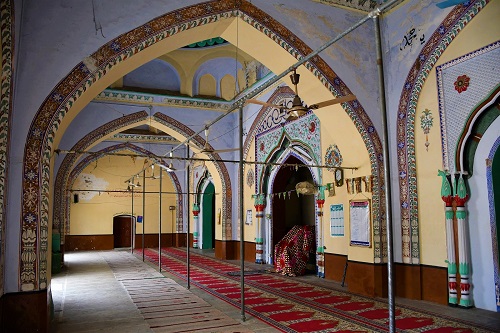
The portico of the imposing mosque opens to a spacious courtyard. It is a three-dome structure with three arched entrances which lead to the vestibule which is spanned with three domes. The vestibule is decorated with paintings. Floral and architectural pillar motifs decorate the walls of the antechamber. There are two inscriptions in the vestibule the first inscription shows the date of construction and the names of the mason and calligrapher. The second inscription shows the name of the calligrapher and Persian poetry. The mason Ghulam Hyder Mistri son of Fazal built a tomb, mosque and well. The painter and calligrapher were Ghulam Mohiuddin Mistri son of Ghulam Hyder. Both father and son worked on the mosque. Ghulam Hyder was a famous mason in the area who was known not only for building mosques, and tombs but also havelis and mansions. There are still a few mansions in the village which were built by Ghulam Hyder Mistri. Ghulam Mohiuddin Mistri was a famous painter and calligrapher of the Dhan area. According to Bashir Ahmed, the grandson of Ghulam Hyder, all three sons of Ghulam Hyder – Ghulam Mohiuddin, Muhammad Din and Sultan Ahmed were famous masons of Tharpal village.
The tomb of Syed Abbas Ali Shah Hamdani is located east of the mosque. This tomb was also built by Ghulam Hyder Mistri. Later it was renovated by Bashir Ahmed Mistri son of Sultan Ahmed in 1985. The renovation work of the tomb was supervised by Syed Muhammad Shah Hamdani, the second Gaddi nashin of the shrine of Syed Abbas Ali Shah Hamdani. There are three graves inside the tomb which belong to Syed Abbas Ali Shah Hamdani, his daughter Takhat Bi and Syed Muhammad Shah Hamdani. There are also a few graveyards outside the tomb which belong to Syed Karam Shah Hamdani, Syed Sher Ali Shah Hamdani son of Syed Muhammad Shah Hamdani, and Syed Tahir Abbas Shah Hamdani son of Syed Muhammad Shah Hamdani.
___________________
 Dr. Zulfiqar Ali Kalhoro, an anthropologist, has authored 12 books: ‘Symbols in Stone: The Rock Art of Sindh’, ‘Perspectives on the art and architecture of Sindh’, ‘Memorial Stones: Tharparkar’ and ‘Archaeology, Religion and Art in Sindh’. He may be contacted at: zulfi04@hotmail.com
Dr. Zulfiqar Ali Kalhoro, an anthropologist, has authored 12 books: ‘Symbols in Stone: The Rock Art of Sindh’, ‘Perspectives on the art and architecture of Sindh’, ‘Memorial Stones: Tharparkar’ and ‘Archaeology, Religion and Art in Sindh’. He may be contacted at: zulfi04@hotmail.com
Courtesy: The Friday Times Naya Daur Lahore